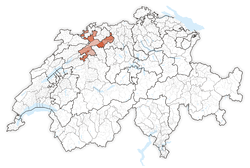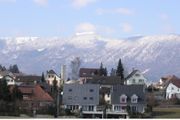Canton of Solothurn
| Kanton Solothurn | |||
|
|||
 |
|||
| Coordinates | |||
| Capital | Solothurn | ||
| Largest city | Olten | ||
| Population | 252,748 (12/2009)[1] | ||
| - Density | 320 /km² (828 /sq mi) | ||
| Area | 791 km² (305 sq mi) | ||
| Highest point | 1,445 m (4,741 ft) - Hasenmatt | ||
| Lowest point | 277 m (909 ft) - Birs at the cantonal border in Dornach | ||
| Joined | 1481 | ||
| Abbreviation | SO | ||
| Languages | German | ||
| Executive | Regierungsrat (5) | ||
| Legislative | Kantonsrat (100) | ||
| Municipalities | 122 municipalities | ||
| Districts | 10 Bezirke | ||
| Website | SO.ch | ||
| View map of Solothurn | |||
|---|---|---|---|
Solothurn (German: Solothurn) is a canton of Switzerland. It is located in the northwest of Switzerland. The capital is Solothurn.
Contents |
History
The territory of the canton comprises land acquired by the capital. For that reason the shape of the canton is irregular and includes two exclaves along the French border, separated from the rest of the canton by Basel-Land, which form separate districts of the canton. Between 1798 and 1803 the canton was part of the Helvetic Republic. In 1803 Solothurn was one of the 19 Swiss cantons that were reconstituted by Napoleon (Mediation). Even though the population was strictly Roman Catholic, Solothurn did not join the Catholic separatist movement (Sonderbund) in 1845. Similarly, the federal constitutions of 1848 and 1874 were approved. The current constitution of the canton dates from 1987.
Geography
The canton is located in the north-west of Switzerland. To the west and south lies the canton of Bern, to the east is Aargau. To the north the canton is bounded by the canton of Basel-Landschaft. Parts of two of the districts are exclaves and are located along the French border. The lands are drained by the Aare river and its tributaries. The landscape is mostly flat, but it includes the foothills of the Jura massif. The flat lands are a plain created by the Aare river. The total area of the canton is 791 km².
Political subdivisions
Districts

From 2005, Solothurn's ten districts are merged pairwise into five electoral districts, termed Amtei. From 2005, the districts have only a statistical significance.
- Bucheggberg, Amtei Wasseramt-Bucheggberg
- Dorneck, Amtei Dorneck-Thierstein (unofficially Schwarzbubenland)
- Gäu, Amtei Thal-Gäu
- Gösgen, Amtei Olten-Gösgen (unofficially Niederamt)
- Lebern, Amtei Solothurn-Lebern
- Olten, Amtei Olten-Gösgen
- Solothurn, Amtei Solothurn-Lebern
- Thal, Amtei Thal-Gäu
- Thierstein, Amtei Dorneck-Thierstein
- Wasseramt, Amtei Wasseramt-Bucheggberg
Municipalities
There are 125 municipalities in the canton (As of 2009[update]).[2]
Demographics

The population is mostly German speaking. About 44% of the population are Roman Catholic, with most of the remainder being Protestants (31% as of 2000[update]).[3] The population of the canton (as of 31 December 2009) is 252,748.[1] As of 2007[update], the population included 46,898 foreigners, or about 18.7% of the total population.[4]
Economy
Up to the 19th century agriculture was the main economic activity in the canton. Agriculture is still of importance, but manufacturing and the service industry are now more significant. The industries of the canton are specialized in watches, jewellery, textiles, paper, cement and auto parts. Until recently the manufacturing of shoes was an important economic activity, but global competition meant that the Swiss canton was not competitive enough.
There is a nuclear power plant near Gösgen which started operation in 1979.
Transport
The canton has good connections with other parts of Switzerland, both by rail and by road. There is a railway junction at Olten with direct trains to Geneva, Zurich, Basel and the Ticino via Lucerne.
External links
- Official site (German)
- Official statistics
 Media related to Canton of Solothurn at Wikimedia Commons
Media related to Canton of Solothurn at Wikimedia Commons
References
- ↑ 1.0 1.1 Swiss Federal Statistical Office, MS Excel document – Bilanz der ständigen Wohnbevölkerung nach Kantonen, Bezirken und Gemeinden (German) accessed 25 August 2010
- ↑ "Liste officielle des communes de la Suisse - 01.01.2008". http://www.bfs.admin.ch/bfs/portal/fr/index/infothek/nomenklaturen/blank/blank/gem_liste/03.Document.90142.xls. Retrieved 15 décembre 2008.
- ↑ Federal Department of Statistics (2004). "Wohnbevölkerung nach Religion" (Interactive Map). http://www.bfs.admin.ch/bfs/portal/de/index/themen/01/05/blank/key/religionen.html. Retrieved 2009-01-15.
- ↑ Federal Department of Statistics (2008). "Ständige Wohnbevölkerung nach Staatsangehörigkeit, Geschlecht und Kantonen" (Microsoft Excel). http://www.bfs.admin.ch/bfs/portal/de/index/themen/01/02/blank/key/raeumliche_verteilung/kantone__gemeinden.html. Retrieved November 5, 2008.
|
|||||

